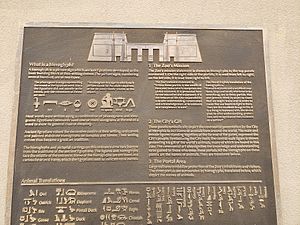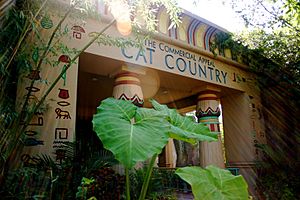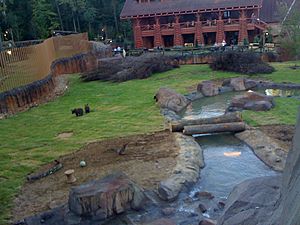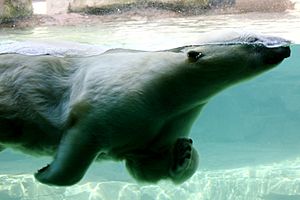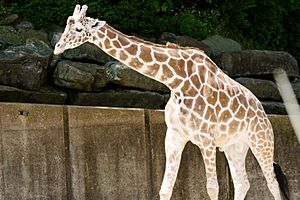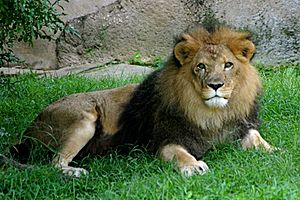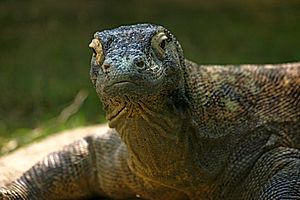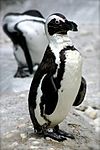Memphis Zoo facts for kids
 |
|
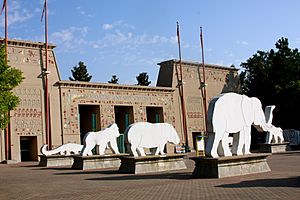
Entrance gate at the Memphis Zoo
|
|
| Date opened | April 4, 1906 |
|---|---|
| Location | Memphis, Tennessee, United States |
| Land area | 76 acres (31 ha) |
| Coordinates | 35°09′00″N 89°59′39″W / 35.1500°N 89.9943°W |
| No. of animals | 3,500 |
| No. of species | 500 |
| Annual visitors | 1.2 million |
| Memberships | AZA |
| Major exhibits | 19 spread across 3 zones |
The Memphis Zoo is a fun place to visit in Memphis, Tennessee, USA. It's home to over 3,500 animals from more than 500 different species! The zoo first opened in April 1906 and has been a big part of Overton Park for over 100 years. The zoo covers about 76 acres, with 55 acres developed for animals and visitors.
In 2008, TripAdvisor named the Memphis Zoo the "#1 Zoo in the U.S." This was based on what visitors thought.
Since the early 1990s, the Memphis Zoo has spent over $77 million to make itself even better. The zoo's animals live in 19 different exhibits, spread across three main areas. Some popular exhibits include Teton Trek, Northwest Passage, and China.
The Memphis Zoo is a proud member of the Association of Zoos and Aquariums (AZA). This means it meets high standards for animal care and conservation.
Exploring the Memphis Zoo: A Journey Through Time
The Memphis Zoo has a long and interesting past, starting over a century ago.
How the Zoo Began
The zoo officially opened on April 4, 1906. It started with $1,200 from the Memphis Park Commission. By August 1906, 23 cages and concrete bear homes were built. This was thanks to Col. Robert Galloway, who led the commission.
The first building, Galloway Hall, was finished in 1907. It was named after Col. Galloway. This building was later taken down to make way for new exhibits.
In 1909, the Carnivora Building was built for the zoo's first big cats. This building was later turned into a restaurant called The Cat House Cafe.
The Elephant House opened in 1910. Today, this building is used for the zoo's education department. The elephants now live in the African Veldt exhibit.
The Botanical Display Building opened in 1916. It later became the Tropical Bird House.
In 1923, the zoo got a round barn from the Memphis Police Department. They used it for their horse patrol. Today, the zoo's Round Barn exhibit houses unique hoofstock and birds.
The zoo's first monkey exhibit, Monkey Island, was built in 1936. It was replaced in 1995 by Primate Canyon.
Mid-Century Growth
The Aquarium was finished in 1959. It's one of the oldest exhibits at the zoo. It's home to animals from both fresh and salt water. It was updated in 1979.
The Herpetarium was built in 1960. It's where you can see snakes, alligators, lizards, and frogs. Later that year, the Pachyderm/Elephant exhibit was completed. The elephants then moved into their new home.
Modern Updates and New Exhibits
The zoo's entrance was updated in 1990. The main entrance, called the "Avenue of the Animals," looks like an ancient Egyptian temple. It has a huge wall with pictures of all the zoo animals. The zoo's mission statement is even written in hieroglyphics!
Cat Country opened in 1993. This 3-acre outdoor exhibit features both predators and prey from the cat world. Tigers and lions share space with smaller animals like fennec foxes and meerkats. An Education Complex and the Elephant's Trunk Zoo Shop also opened then. The old Carnivora Building became The Cat House Cafe in 1994.
Three new exhibits opened in 1995. Animals of the Night lets you see nocturnal animals when they are most active. Once Upon A Farm looks like a farm from the early 1900s. Primate Canyon has natural outdoor areas for many types of monkeys and apes.
Dragon's Lair opened in 1998 for the zoo's three Komodo dragons. It has both outdoor and indoor areas to keep them warm. A new animal hospital also opened in 1998. It has special areas for sick animals and for new animals to stay in quarantine. The Butterflies: In Living Color exhibit also opened in 1998. It was later replaced by "Birds and Bees" in May 2009.
In April 2003, the Memphis Zoo became one of only four U.S. zoos to have giant pandas. This was part of a 20-year loan. A male panda, Le Le, and a female panda, Ya Ya, lived in a 3-acre exhibit. This exhibit was designed to look and sound like China. Le Le passed away in February 2023. Ya Ya was successfully returned to China in May 2023 when the loan ended.
The Northwest Passage exhibit opened on March 1, 2006. Here, you can watch polar bears and sea lions swim underwater. The animals often play with visitors. The sea lions love to follow and copy children!
Butterflies: In Living Color! was updated in 2007. It housed up to 1,000 butterflies of 35 different species. There were 56 types of plants for the butterflies to eat.
Construction for the Teton Trek exhibit began in February 2008. This exhibit opened on October 10, 2009.
The zoo had its busiest day ever on March 17, 2009, with over 20,450 visitors. In late May 2009, the Birds and Bees exhibit opened. The butterfly garden moved outside the aviary.
The zoo's second African exhibit, Zambezi River Hippo Camp, opened on April 29, 2016.
Amazing Exhibits to Explore
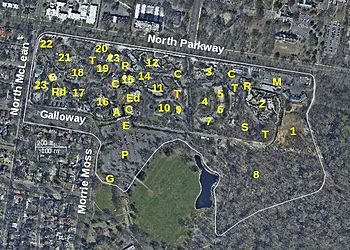
2 Northwest Passage
3 Elephants, rhino
4 Bongos, gazelles, ostriches
5 Zebras, oryx
6 Bonteboks
7 Giraffe
8 Chickasaw Bluff Trail (planned)
9 Birds and Bees (seasonal)
10 Waterfowl
11 Primate Canyon
12 China Exhibit
13 Hippos
14 Bonobos
15 Animals of the Night
16 Cat Country
17 Tropical Bird House
18 Penguin Rock, pelicans
19 Herpetarium
20 Dragon's Lair
21 Round Barn
22 Aquarium
23 Once Upon A Farm
C Concessions
E Entrance Plaza
Ed Education Center
G Gate to parking
M Maintenance
P Parking
R Restrooms
Rd Rides
S Ice skating (seasonal)
T Picnic tables
The Memphis Zoo has modern exhibits that look like the animals' real homes. Some of these are Once Upon A Farm, Cat Country, Primate Canyon, Dragon's Lair, Animals of the Night, Tropical Bird House, Herpetarium, Aquarium, African Veldt, Zambezi River Hippo Camp, China, Northwest Passage, and Teton Trek.
Walking through all the exhibits takes about 2 miles. You can also take a tram for a guided tour. Other fun things at the zoo include a carousel, rides, a miniature train, and gift shops. There's a playground near the Cat House Cafe and picnic areas. An ice skating rink is open in winter. You can also ride camels and feed giraffes for a fee.
The zoo is split into three zones with 19 different exhibits.
East Zone Exhibits
Teton Trek: A Yellowstone Adventure
This 4-acre exhibit opened in October 2009. It brings the feel of Yellowstone National Park to Memphis. Teton Trek starts with a 25-foot tall copy of the Old Faithful Geyser. There's also a large building called the Great Lodge, like the Old Faithful Inn. Here, you can learn about the animals.
This exhibit is home to animals from the Yellowstone area. You can see grizzly bears, elk, timber wolves, trumpeter swans, and black bears. The trail lets you see bears swimming underwater. You can also enjoy a view from a 25-foot tall waterfall.
Northwest Passage: Arctic Wonders
This $23 million exhibit opened on March 1, 2006. It has an underwater viewing area for polar bears and sea lions. There's also a 500-seat theater for sea lion shows. This exhibit celebrates the culture of the First Nations people in British Columbia. It also features animals and plants from the Pacific Northwest.
Messages about protecting nature are found throughout the exhibit. Six hand-carved totem poles stand in the area. The Northwest Passage is also home to bald eagles and white-necked ravens.
African Veldt: Safari Fun
Here, you can see African elephants, white rhinos, and giraffes. They share their home with zebras, Grant's gazelle, and ostriches. Other animals include African cranes, bontebok, lechwe, bongo, and scimitar oryx. The elephant exhibit was made bigger in 2006. It now has a pool where elephants can swim and bathe.
World of Waterfowl: Wetland Wonders
In this exhibit, two wooden bridges take you through a wetland. It's home to about 30 Chilean flamingos and many other waterfowl.
Birds and Bees: A Buzzing Aviary
This exhibit opened in May 2009. It lets you see two honey bee hives up close. Displays explain how special bees are and how they help with agriculture. The indoor bee exhibit leads to an outdoor aviary. Here, you can see about 500 budgies, also known as parakeets. You can even feed them with millet seeds on sticks!
Central Zone Exhibits
China: Home of the Pandas
Opened in April 2003, this $16 million exhibit is designed to look like China. The Memphis Zoo was one of only four U.S. zoos to have giant pandas. Other animals from China include Sulawesi Black-crested macaques, Père David's deer, red pandas, and colorful birds like the golden pheasant.
Primate Canyon: Monkey Business
This exhibit opened in 1995. It has natural outdoor areas for western lowland gorillas, Sumatran orangutans, and siamang gibbons. Other primates here include lion-tailed macaques, black-and-white ruffed lemurs, and savanna baboons.
Commercial Appeal Cat Country: Big Cats and More
This 3-acre outdoor exhibit is home to African lions, cheetahs, Amur leopards, meerkats, caracals, cougars, Sumatran tigers, and snow leopards. The exhibit uses architecture from the animals' native lands. For example, temple ruins surround the Sumatran tiger exhibit. The old Carnivora Building, where the cats used to live, is now the Cat House Café restaurant.
Zambezi River Hippo Camp: African Adventure
This African exhibit opened in 2016. It's home to hippos, Nile crocodiles, okapi, and yellow-backed duikers. You can also see Cape vultures, mandrills, and patas monkeys.
- Bonobos
Six bonobos live in this indoor/outdoor exhibit. This includes a baby bonobo born in 2005. The bonobo is an endangered animal found only in the Democratic Republic of Congo.
Animals of the Night: When Animals Come Alive
This exhibit reverses the day and night for nocturnal animals. This way, you can see them when they are most active. The exhibit has a central bat flyway. This lets you see bats flying and feeding up close. You can also see many other species, from aardvarks to wombats.
West Zone Exhibits
Dragon's Lair: Giant Lizards
This exhibit was built for the Komodo dragon, the world's largest lizard. The zoo's three dragons have outdoor and indoor areas. This keeps them warm during cooler months. Keepers often show how they feed the Komodo dragons on Saturdays.
Tropical Bird House: Colorful Feathers
You can see many colorful birds in outdoor areas at the entrance to the Tropical Bird House. The building itself is home to exotic birds from around the world. These include the pygmy falcon, Burrowing owl, and Toco toucan. The exhibit has a walk-through aviary. This lets you get close to many birds, especially during feeding time.
Aquarium: Underwater Worlds
The Aquarium is one of the zoo's oldest exhibits. It has aquatic life from both fresh and salt water. Some cool animals here are Fly River turtles, electric eels, red bellied piranhas, and green moray eels. The electric eel exhibit has a special feature. It turns the eel's electric pulses into sounds and a light show!
Penguin Rock: Wobbly Walkers
Over 30 African penguins live at Penguin Rock, across from the zoo's rides area. American white pelicans are also nearby.
Once Upon A Farm: Farm Life Fun
This exhibit looks like a farm from the early 1900s. It's home to Caspian horses, domestic goats, prairie dogs, and miniature cows. Besides farm animals, there's a vegetable garden, a cotton patch, and rows of corn. This shows visitors what a southern farm was like.
Herpetarium: Reptiles and Amphibians
Located across from the Tropical Bird House, the herpetarium is home to the zoo's snakes, like the Burmese python. You can also see American alligators, lizards, and frogs. It has rare snakes like the Louisiana pine snake. You can also see some of the world's most venomous snakes, like the Eastern green mamba. It's home to an alligator snapping turtle and Galápagos tortoises.
Round Barn: Unique Hoofstock
The Round Barn is home to gerenuks, known for their very long necks. Keepers place tall bamboo stems in their exhibit to encourage them to forage. This exhibit also houses Abyssinian ground-hornbills, warthogs, red river hogs, and dama gazelles.
More to See and Do
Beautiful Landscaping
The zoo's landscaping is a big part of its beauty. You'll see water features like ponds and waterfalls. There are also artificial rock formations that blend into the animal enclosures. The zoo has many different trees, shrubs, and seasonal plants.
Many large trees are native to the area, like sweetgum and sycamore. Some exhibits feature plants that match their theme. For example, the China Exhibit has Chinese fringetrees. The Northwest Passage and Teton Trek Exhibits have western conifers.
Several gardens are kept within the zoo where the plants are the main attraction. Tropical plants are also grown in summer.
Exciting Events
The Memphis Zoo hosts many special events throughout the year. These include Horticultural Tours, a Plant Sale in April, and Zoo Boo with its Haunted Forest in October. In November and December, there's Zoo Lights with over 1 million holiday lights. There are also many educational activities for school-aged children.
Exzoobrance Magazine
Exzoobrance is a magazine published every two months by the Memphis Zoological Society. It keeps visitors updated on zoo activities. Each issue has a calendar of events, news about education and conservation, and information about the animals. It also has a fun activity page for kids.
Zoo Incidents
Sometimes, unexpected things happen at the zoo. On January 8, 2008, a stray dog got into the zoo and jumped into the tiger exhibit. Zoo staff quickly helped the dog get out safely. It had some injuries but survived.
In May 2009, a zookeeper was bitten by a Bengal tiger. This happened because two safety doors were not closed. The tiger was safely returned to its exhibit.
In 2019, a person accidentally shot themselves with a hidden handgun while entering the zoo. This led the zoo to review its safety policies.
See also
 In Spanish: Zoológico de Memphis para niños
In Spanish: Zoológico de Memphis para niños



